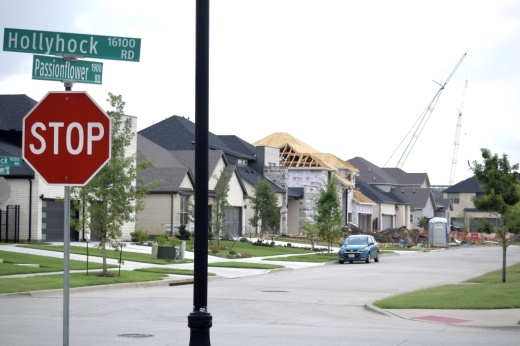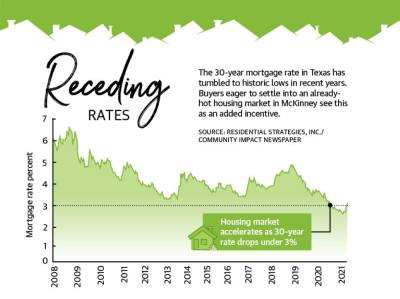Local real estate experts say it could be another year before the real estate scene stabilizes and have cited historically low interest rates as another driver of market conditions.
“It’s interesting,” said Phil Crone, executive director at the Dallas Builders Association. “With price increases and supply chain issues ... I’ve been doing this for 15 years, and I’ve never seen anything like it.”
The Collin County Association of Realtors reported that county homes in May remained on the market for 67.9% less time than last year and sold for 105.7% of their original list price on average. The median sales price of $437,650 is 26.9% more than the year prior.
“Demand for Collin County homes is high and supply remains short, which means prices go up,” said CCAR President Ron Leach in the report. “It’s an extremely rewarding market for sellers, and it is a really hard market for buyers.”
Frisco is located in both Collin and Denton counties. For Collin County, CCAR reported 0.9 months supply of homes for sale. For Denton County, the Greater Lewisville Association of Realtors tracks the data and reported 0.8 months supply for May. A market is considered balanced when there is a 6-month supply of homes for sale.
Mayor Jeff Cheney, who owns the Cheney Group real estate firm, said he believes the imbalance will begin to stabilize in the months to come.
“I do think we’re past that first, initial, big increase in pricing, and things will start leveling off moving forward,” Cheney said. “[But] I do expect there to be limited supply for at least the next 12 months.”
Cheney said he has never seen a market dynamic like this in his nearly 20 years as a real estate agent. Clients, he said, may be waiting weeks—if not months—before property is available to tour. Oftentimes, Cheney said homebuyers are forced to make decisions on the spot.
Many homebuilders in Frisco are behind schedule substantially on their initial projections, he said. Cheney added that many builders are queuing would-be buyers on waitlists that span longer than a year.
Constraints on homebuilding supplies such as lumber and metal are to blame for the delays, alongside a labor shortage. Both of these factors Cheney attributed to the pandemic. In addition, the growing prevalence of working from home is influencing families to seek homes in Frisco they otherwise would have avoided due to commute times.
Cheney’s prediction about the eventual rebalancing of the market is due to COVID-19 restrictions waning and builders catching up. As mayor of Frisco, Cheney said he also believes big businesses that seek to move to Frisco, such as the PGA of America, share his belief that the market imbalance is temporary. Cheney said corporate entities seeking to move to Frisco aren’t discouraged by the housing shortage.
“It’s not going to last forever,” Cheney said. “Eventually, we’re going to see the cycle change, and things settle down, hopefully sooner than later.”
Emboldened buyers
John Porizek, land development manager with M/I Homes of DFW, believes a more even split of supply and demand depends on the 30-year mortgage rate rising above its current historic low.
M/I Homes builds out lots in the north Frisco Hollyhock community southeast of US 380 and FM 423. Porizek said his team is forced to cap monthly sales due to overwhelming demand and limit spending on marked-up building materials.
“Interest rates would have to continue to go up to slow the pace down,” Porizek said. “With the interest rate still being very attractive, it allows first-time homebuyers that opportunity to acquire a loan.”
Predating the pandemic, the plummeted mortgage rate has been the most significant factor to heightened demand, according to Dallas-based research firm Residential Strategies Inc.
The rate in Texas is 2.98%, the first-quarter report from RSI reads, down considerably from just under 5% in 2019.
A pandemic made already eager families even more set on buying homes, according to Porizek.
“A lot of people were working from home,” Porizek said. “It was more desirable for people to get into a home and do upgrades to a home because they were spending more time there.”
A misaligned market
Crone with the DBA seeks to advocate, educate and communicate on behalf of the builders, remodelers and Realtors who comprise his organization.
Crone said the current market is defined by lost business for both homebuilders and buyers.
Tight supply chain issues and corresponding housing supply problems will persist through the summer and well into the fall, he said. The director thinks real estate in the Dallas-Fort Worth region is heading in the right direction as peak buying season passes and COVID-19 vaccination rates that boost the homebuilding workforce continue to rise. Many families, however, are left on the sidelines as average home prices have gone through the roof.
“Builders want to build every home that’s being demanded out there, and the more these prices go up, the fewer people have that opportunity,” Crone said. “The more [builders are] constrained by the amount of homes they can build by the supplies that they’re getting, the fewer families they can put in homes. And that’s not good business.”
He said the DBA hopes to see action on a federal level to even out supply and demand for homes in North Texas. For instance, Crone said a lawmaker summit on lumber would strengthen the market, one that would perhaps widen options for where lumber is harvested in the U.S.
In the meantime, the DBA advocates for builders to discover ways to build houses with less lumber needed.
“Homes are one of the few things that are actually built and fabricated out in the field, not in a factory or closed environment,” Crone said. “So finding efficiencies there where the job site may not always be conducive for it I think is a challenge, but there’s also an obvious benefit there.”
Crone shares the belief that an already prime housing market in the Frisco area was made even more appealing by a perspective change from the pandemic. Commuting has become less of a concern due to increased work-from-home options and that, combined with “a lot of pent-up demand” among millennials, has caused the floodgates to open, he said.
“Home became more essential than ever,” Crone said. “Everybody realized that, like it or not, they’re going to be spending a lot more time there.”







